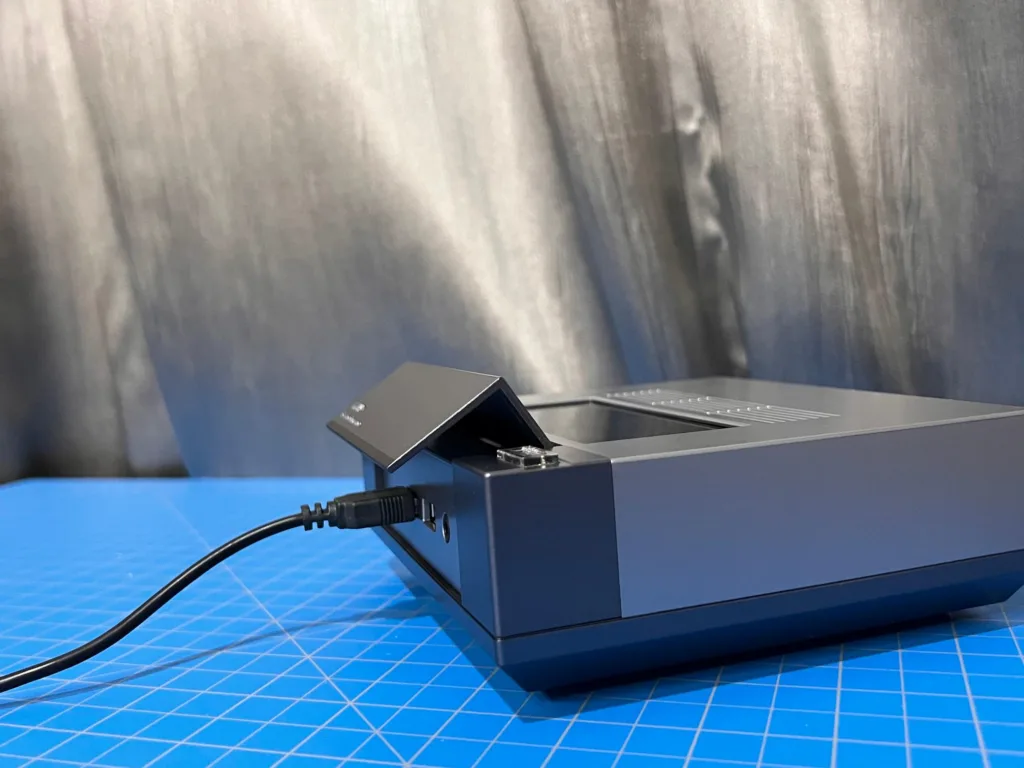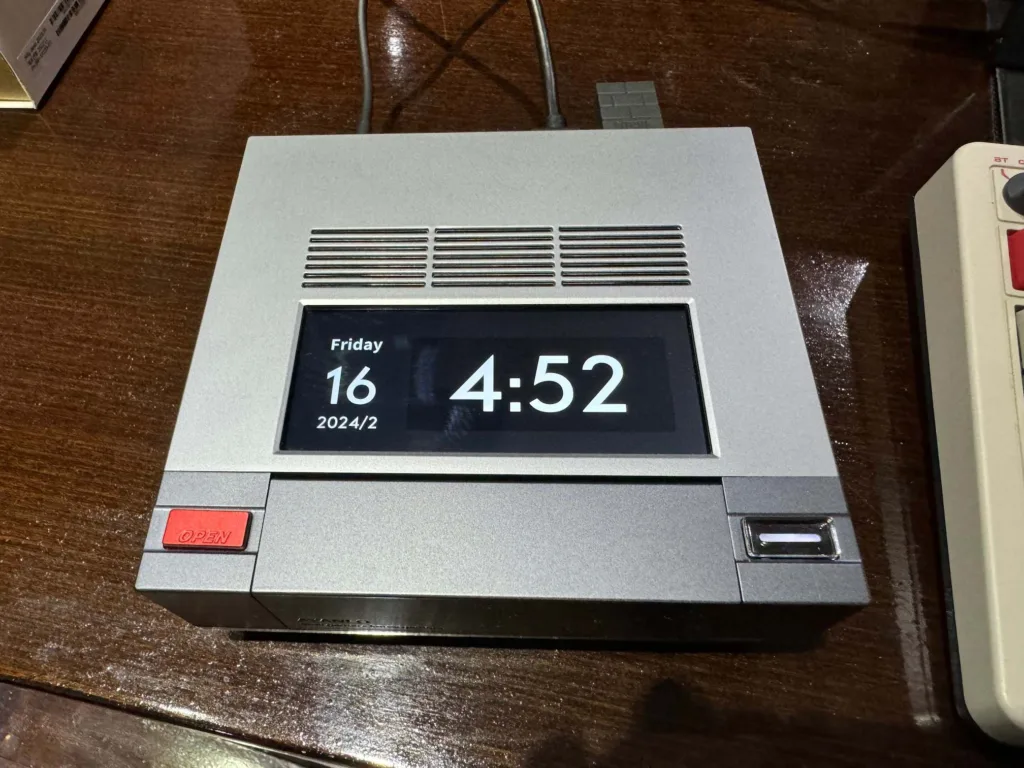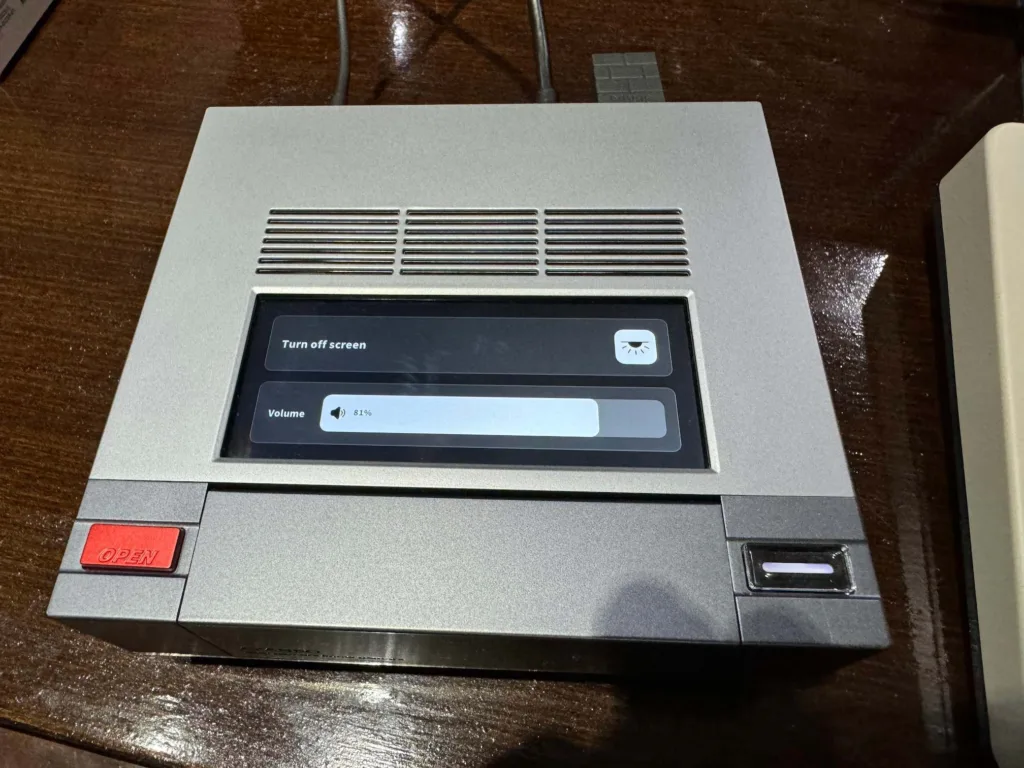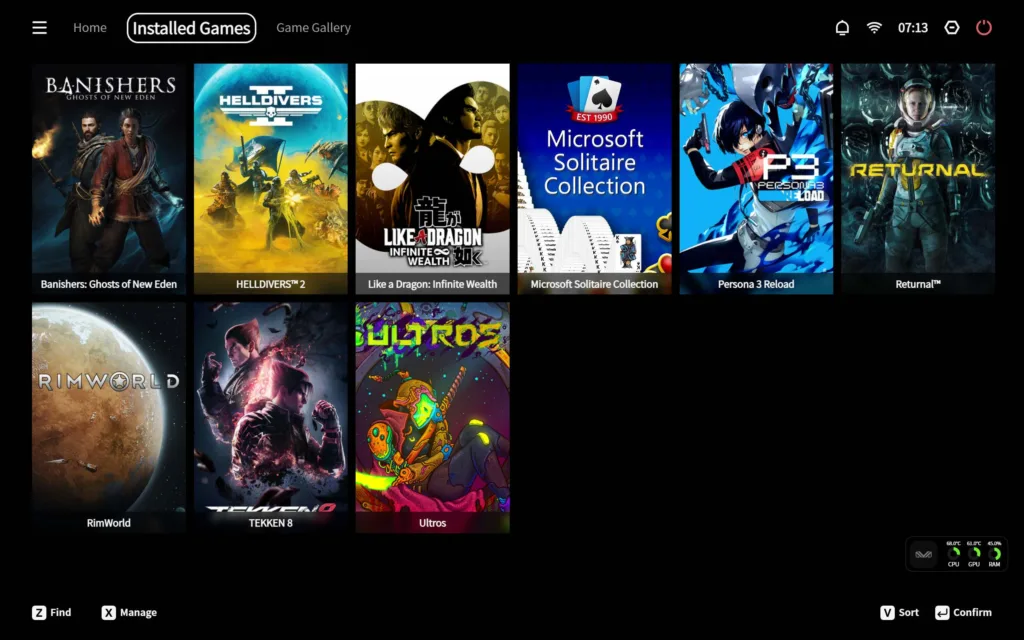
The Mini PC AM02 was provided to us by AYANEO for review. Thank you!
With AYANEO’s new retro-aesthetic approach to their recent devices, they announced two mini PCs: The AM01 and AM02. Both of these have a unique aesthetic that goes along with them and push for productivity over gaming for the most part. In our review of the AM01, we noted the incredible price, competent performance, and fantastic Macintosh Computer aesthetic that helped it stand apart from other similar Mini PCs. Now, the AM02 is here, and it may be what sets me over the edge to make the AM01 a secondary PC rather than my main one.

Sporting a more powerful processor and a unique SNES-like design, the AM02 comes packed with some intriguing features, both internally and externally. I felt AYANEO hit it out of the park with its first design, and for the most part, I feel similarly with this one. There are a couple of changes that give this one an edge, though, including its neat touchscreen on the top that you can interact with in numerous ways. In the end, it makes this the ultimate Mini PC for gaming and productivity and puts it all into a one-of-a-kind design.
As usual, I want to start with the hardware and what you can expect in this Mini PC and all of its models. In each AM02, you can expect:
On top of those, we have a multitude of ports covering the mini PC’s front and back:


As for the models, there are four different combinations with different price points that are on sale now on Indiegogo. These are early bird prices, so after the campaign ends, they will go to the retail price point. We have one barebone model, which comes with everything but the RAM, Storage, and pre-installed OS, and three models with different combinations of RAM + storage:
Each model also comes with:
This is another fantastic price point for a device like this. While the predecessor model was a bit cheaper, the Retro Mini PC AM02 has a significantly more powerful chip that will be able to handle some of the newest games with ease. This is thanks to both the 7840HS APU and the use of DDR5 RAM. As someone who is used to playing with compromises on a handheld, it is quite nice to utilize some more powerful tech while keeping the portability factor.
As for the model I have, I was sent a 32gb RAM + 1tb SSD version. As this is the most powerful, I will be watching RAM and testing primarily from within the 16 GB range while noting what makes the extra RAM worthwhile, especially from a machine designed for stationary use. Now, let’s get into the review.
As I mentioned above, AYANEO is releasing more retro-themed machines, and the most unique ones are the Mini PCs. The AM01 had an older Macintosh-like design, which could be customized with stickers and magnets. The AM02, however, opted for a different design based on Nintendo’s SNES that sports some very cool, unique features.


Of all the features here, the most noticeable one is easily the touchscreen on the top of the PC. This 4-inch touchscreen is capable of showing some information that otherwise may be hidden or hard to get to while busy gaming. This includes a performance overlay, which displays the FPS, TDP, Fan speed, Up/Down internet speed, storage space, RAM usage, and specific stats for CPU and GPU, a clock and weather widget, and a way to adjust the system volume and turn off the screen altogether.
I love this mini-screen. While I am used to playing with a performance overlay on my screen for reviews, having it on the device instead frees up my screen from the overlay, and I can play my games with ease. I also really like being able to see the time and change the system volume so easily, as I tend to adjust the volume countless times as I play, and doing it this way is really wonderful. There have been a couple of times the screen desynced from AYASpace and stopped showing any statistics, but I know it’s something AYANEO is working on with updates. It is a little hot to touch as well, but you really only feel it if you keep your finger on it for a prolonged time. If you are just swiping to different screens, you won’t feel it.
The AM02 also has a little cover that pops open on the front to reveal the front ports. You can open this using the red button on the left on the top of the AM02, while the button on the right is what turns it on. Pushing both buttons feels extremely satisfying, and the cover that opens is sturdy. It all really adds to the overall theme they are going for visually, and I feel like they hit it out of the park. The only thing that may annoy some people is when anything is plugged into the front, the cover can’t close. While this seems obvious, it can be a nuisance to have to keep it open when it looks very flush when closed.

The model looks and feels sleek and well-built, too. The shell is plastic, but it feels very tight. With its size being a little more wide than the predecessor, I expected it to feel a bit more heavy, but it doesn’t one bit. The device is very nice to hold and doesn’t weigh as much as a lot of my other devices, so moving it around is very easy.
As for the heat dissipation, the intake fan is on the bottom of the PC, while the exhaust is on the back of it. There is an extra passive heat dissipation vent on the top. Because of this, the heat tends to congregate around the top of the device, above the intake vent, and away from power and the red “Open” button, and it works well. Thankfully, I never found that it got too hot to touch, and the 4-inch screen never really felt toasty either.
For general use, the AM02 holds its own wonderfully. With the device using Windows OS, I had no trouble finding and launching the programs I typically like to use while I work. For browsing, writing, and researching, the experience is flawless. I wouldn’t have expected otherwise since these aren’t resource-heavy tasks, but it’s nice regardless. One thing I will note is that everything felt speedy and quick to launch, which are both fantastic.
I also really enjoyed using the small screen on the top here. Being able to change TDP presets and volume without needing to stop what I am doing on the big screen is helpful. And, if I am using or watching something in full screen, I can check the time with ease:



To test heavy use, I decided to use the AM02 for some of our upcoming projects, which include video editing, gameplay/sound recording, and Photoshop. I decided to also use the Adobe programs for all of them, and I am so happy to say they work well. I used Photoshop and recorded gameplay and audio while running other processes, taking up about 14gb of RAM, and I had no slowdowns whatsoever. Everything also loaded fairly quickly. This was all on a 14W TDP limit too, which is even better!
As for video editing, I cranked up the TDP limit and rendered a 35-minute 4K video. While it did slow the computer down while exporting, understandably, it took about 15 minutes to complete. I was actually quite impressed with this, but that could partly be due to being used to handhelds with more limited power. I didn’t experience any slowdowns when editing and it was a very smooth process overall.
As with all of AYANEO’s devices, we have a version of AYASpace that has been integrated to help manage the system. This software is fantastic for handhelds and allows us to control TDP limits and fan speeds, set up performance overlays, utilize shortcut commands, set framerate limits, and more. While I do love AYASpace for handhelds, it is one of my favorite Quick Access Management (QAM) tools. It’s not really great for Keyboard and Mouse devices.

The overall interface is geared more towards handhelds or gamepad use. The quick access menu is still useful, and has those amazing shortcuts to bring up Device Manager and Control Panel with ease, the overall feeling of the menu is a bit too big and blocky. If they changed this up to be more of a shortcut list with the FPS limiter and always kept TDP at its highest, that would be awesome.
As for the settings in AYASpace, you can adjust a plethora of settings, including details for what your second screen will show. If this is integrated into AYASpace, I will be extremely happy, though you can turn the screen on and off. You can also use the AYASpace app to bring all of your games together in one place from across all the different storefronts, which is nice, but I ended up just using the other launchers more.

Overall, it isn’t a terrible tool to utilize, but I do wish it was more optimized for Keyboard and Mouse-centric devices like Mini PCs. Luckily, that is something that can be improved via software updates, so I am not as worried about it.
Then, we get to how it will perform with games. The AM02 uses a 7840HS APU, which utilizes the 780M integrated GPU, as well as full-powered DDR5 RAM, and can withstand more power. Going into this, I had complete hope that playing games on this would be a better experience than handhelds that use the 7840U, and for the most part, I was right!
I will be focusing more on tougher games to run in this section since smaller games like Stardew Valley will run without issue. I also prioritized running every game at 1920×1080 resolution, as this is the standard for most PC monitors nowadays.
With some compromises, Helldivers 2 is playable at 30 FPS! It requires low/medium settings and balanced rendering quality, and there may be some dips to 27-28 FPS, but it is hard to feel it when you are focused on 30. I still found the game to be very playable and look great. Dying has never been so much fun.
I haven’t played Returnal on PC at all, since I mostly use handhelds to run games nowadays, and I am so happy to say I am actually able to play it on the AM02! Using lower settings with FSR, I was able to hit 40 FPS most of the time and 30 FPS the entire time. This is partly thanks to having 32gb RAM, but I am so happy nonetheless.
At medium graphics settings with FSR 2.2 on, we can expect around 40 FPS with some minor dips. If you are okay with setting it to a 30 FPS limit, you will have an incredible-looking game with a stable framerate. You can go down to low with a lower FSR setting and get closer to 60, but it is too much of a compromise and I wouldn’t recommend it.
Another great game that runs wonderfully on the AM02. At 1920×1200 resolution, I was getting 60 FPS without much trouble. Of course, this was with ray-tracing reflections off, but otherwise, it runs with ease.
With medium settings and TAAU upscaling at 55, we can hit 60 FPS in TEKKEN 8 easily without much compromise to visual quality! This is awesome, and having the extra effects from the medium preset while having the excellent upscaling keep the fantastic quality is a real treat.
A smaller game that is very CPU-heavy, I had no trouble playing RimWorld for long periods of time with over 100 mods loaded in. I played this for hours and had little, even as my colony started to grow. I would say as I got to over 10 colonists, I noticed a little slowdown, but if you are playing RimWorld with little to no mods, or using optimizing mods, you will definitely not slow down as early.
The AYANEO Retro Mini PC AM02 is an excellent miniature PC that finds an amazing balance with gorgeous aesthetics and power to bring together one of the best values for a mini PC. With a starting price tag of $529, we get slightly better performance than the flagship handhelds that are available for $200 more and a unique NES-styled shell with a small screen on it to display performance statistics and change settings. I love the screen’s use, and I absolutely adore the overall design of the PC.
While I do wish AYASpace was better optimized, I didn’t see many issues with the device other than the front flap needing to be kept open when anything is plugged in. Otherwise, everything works; the machine is powerful, and I love it. They took what made the AM01 so wonderful and made a high-end version of it with an awesome design that is still pretty affordable for what you are able to play and do with it. If you want a more stationary PC that looks amazing with a cool little screen on it but also wants to play some of the newest games at a stable framerate, look no further!
If you enjoyed this review, check out the rest of the content on HandheldHQ! We have a wide variety of reviews and news that are sure to help your gaming experience. Whether you’re looking for news and handheld reviews, or just want to stay up-to-date on the latest trends, we’ve got your back.

